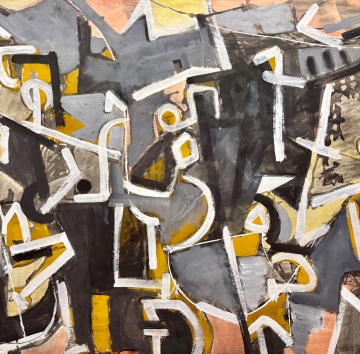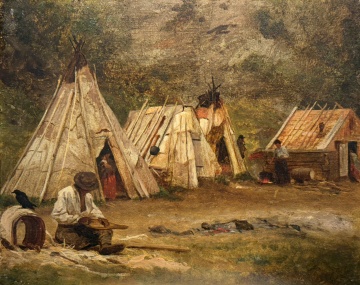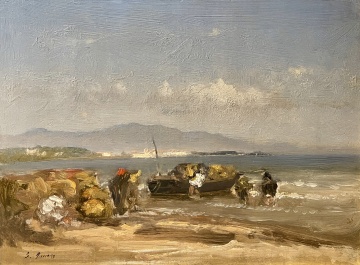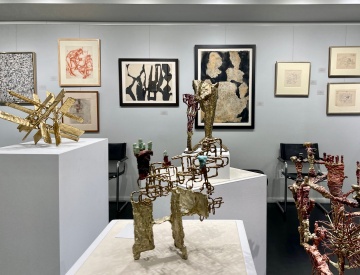Graham Shay 1857
17 East 67th Street, No. 1A
New York, NY 10065
212 535 5767 | 917 742 7813
New York, NY 10065
212 535 5767 | 917 742 7813
Graham Shay 1857 is a private art gallery, specializing in fine American paintings and American and European sculpture, spanning a time-period from the 1840’s through the 20th Century. The elegant space, in a private apartment building, is steps off Madison Avenue, in the midst of the Upper East Side museum and gallery district.
Director Cameron M. Shay has been in the American art business for 40 years and has placed works in leading institutions and distinguished private collections. He is recognized for his expertise in American and European sculpture of the 19th and 20th Centuries. The Gallery has an active exhibition program and is looking forward to showing exemplary works in a fresh space. Amongst the genres shown at the Gallery are historic American art, important American sculpture, the Hudson River School, the Ashcan and New York school painters, Western and wildlife art, American modernism, abstract paintings and sculpture. Artists of particular focus include Guy Pene du Bois, Everett Shinn, John White Alexander, Helen Torr, Oscar Bluemner, Thomas Hart Benton, Frederic Remington, Harriet Frishmuth, Charles M. Russell, Antoine-Louis Barye, Rembrandt Bugatti, Norman Bluhm, Gertrude Vanderbilt Whitney, William Zorach and Paul Manship.
Artists Represented:
Contemporary:
Robert Engman
Contemporary:
Robert Engman
Johnny Hawkes
Amy Kann
Cornelia Kavanagh
19th and 20th Century:
John White Alexander
Richmond Barthe
Antoine-Louis Barye
Thomas Hart Benton
Albert Bierstadt
Oscar Bluemner
Norman Bluhm
Isidore Bonheur
Rembrandt Bugatti
Jean-Baptiste Carpeaux
Frederic Church
Allan Clark
Abastenia St. Leger Eberle
Perle Fine
Harriet Frishmuth
Childe Hassam
Robert Henri
Malvina Hoffman
Mario Korbel
Boris Lovet-Lorski
Frederick MacMonnies
Paul Manship
Edward McCartan
P.J. Mene
Thomas Moran
Guy Pène du Bois
Henry Varnum Poor
Frederic Remington
Auguste Rodin
Charles M. Russell
Augustus Saint-Gaudens
Everett Shinn
Kimber Smith
Miklos Suba
Alexander Tatti
Paul Troubetzkoy
Jack Youngerman
Shelly Malkin
Paul Resika
Reeve Schley
John White Alexander
Richmond Barthe
Antoine-Louis Barye
Thomas Hart Benton
Albert Bierstadt
Oscar Bluemner
Norman Bluhm
Isidore Bonheur
Rembrandt Bugatti
Jean-Baptiste Carpeaux
Frederic Church
Allan Clark
Abastenia St. Leger Eberle
Perle Fine
Harriet Frishmuth
Childe Hassam
Robert Henri
Malvina Hoffman
Mario Korbel
Boris Lovet-Lorski
Frederick MacMonnies
Paul Manship
Edward McCartan
P.J. Mene
Thomas Moran
Guy Pène du Bois
Henry Varnum Poor
Frederic Remington
Auguste Rodin
Charles M. Russell
Augustus Saint-Gaudens
Everett Shinn
Kimber Smith
Miklos Suba
Alexander Tatti
Paul Troubetzkoy
Jack Youngerman
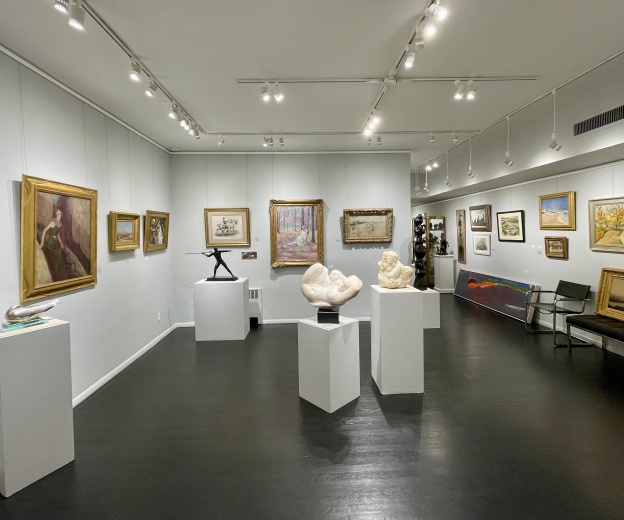
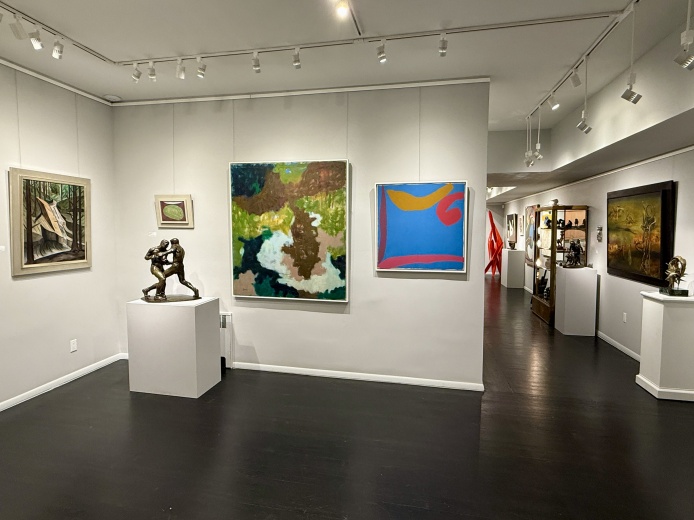
Install view 1
Install shot 3
Anna Walinska
Anna Walinska West Meets East: An Artist’s Journey Around the World, 1954 - 1955
June 4, 2025 - July 11, 2025
In November 1954, Anna Walinska set out on a six month trip around the world, visiting 15 countries in 183 days, including a 4-month sojourn in Burma. Works in this exhibition were inspired by that trip.
“It was the end of so much that was precious and very beautiful, and I was very fortunate that I came at a time where even though the West had encroached with the clothes and certain values, still there was a mixture of the two, a juxtaposition which was fascinating.”
-Anna Walinska on her time in Burma
Graham Shay at The American Art Fair, 2025
May 10, 2025 - May 13, 2025
Graham Shay returns to The American Art Fair in its 2025 iteration, presenting a selection of fine American and European paintings and sculpture.
Graham Shay at the Philadelphia Show, 2025
April 25, 2025 - April 27, 2025
Graham Shay and Lincoln Glenn present jointly at The Philadelphia Show 2025.
Thomas Hart Benton, Guy Pene du Bois, Everett Shinn, Robert Henri, John Henry Twachtman
150 Years of Influential Instructors: Historical Teachers at the Art Students League, 1875-2025
January 16, 2025 - February 28, 2025
Lincoln Glenn and Graham Shay galleries return to recognize the contributions of some of the historical instructors of the Art Students League as we mark its 150th anniversary. From Frank Vincent DuMond to Adolph Gottlieb, Paul Manship to Charles Alston, Charles Hawthorne to Wolf Kahn, Guy Pene du Bois to Augustus Saint-Gaudens, instructors of the Art Students League have had a profound influence in molding American art. The League was founded in 1875 due to artists’ increasing dissatisfaction with the National Academy’s conservative and traditional perspective. Throughout its esteemed history, the League has served as an institution run by artists in support of artists. The present exhibition displays a wide array of genres, periods, media, and artists associated with teaching “League” classes in celebration of its 150th anniversary.
The League opened at 108 Fifth Avenue, on the corner of 5th Avenue and 16th Street, and held its first classes in half a room on the building’s top floor. The school, which offered life drawing classes every day of the week, was membership-based. There were no grades, no set courses, and no degrees offered. Instead, the League was run like a French atelier, promising small classes and granting the instructor a studio and freedom to teach whatever they deemed appropriate. As membership continued to grow, the League relocated to increasingly larger spaces. In recent years, the legacy of the school remains, as the League continues to educate a wide variety of young artists, both professional and amateur.
Some of the other faculty represented in the exhibition include Al Loving, Kikuo Saito, Chaim Gross, William Zorach, Everett Shinn, Jose de Creeft, Theodore Stamos, Max Weber, and Jacob Lawrence. The exhibit will explore the variety of artistic expressions of Arts Students League instructors, through over a century of artistic production.
This joint exhibition will be on display January 16 - February 28 at 17 East 67th Street, and the gallery will be open to visitors 10 am – 6 pm, Mondays – Saturdays. The exhibition will be accompanied by a complimentary catalogue with an essay by Jonathan Spies. An opening reception will be held on Thursday, January 16th from 5:30-7:30pm.
Cecilia Beaux, Harriet Frishmuth, Malvina Hoffman, Louise Nevelson, Anna Walinska
A Celebration of the 135th Anniversary of the National Association of Women Artists, Est. 1889
March 28, 2024 - May 31, 2024
After jointly presenting a show of 1913 Armory Show exhibition artists this past fall, Graham Shay 1857 and Lincoln Glenn return this spring to recognize the contributions of some of the thousands of women artists who were members of NAWA. Founded in 1889, the organization is the oldest women artists' collective in the United States and has provided a community for professional women artists, promoting the work of its members through annual exhibitions, traveling shows, awards, and educational and outreach programs. Throughout its illustrious history, NAWA’s membership has included the likes of Mary Cassatt, Bessie Potter Vonnoh, Gertrude Vanderbilt Whitney, Blanche Lazzell, Isabel Bishop, Doris Lee, Dorothy Dehner, Louise Nevelson, and Faith Ringgold in its ranks.
Just as Virginia Woolf believed that women authors needed a modest wage and a room of their own to write fiction, women artists have searched for a place to exhibit their work and a group of their peers to provide artistic and intellectual support. The National Association of Women Artists (NAWA) (and originally called the Woman's Art Club of New York) was founded by five women who felt isolated from a community of their peers and from the opportunity to exhibit their art. They provided women with an alternative to the male-dominated National Academy of Design and Society of American Artists in New York, which continued to bar women from participating in many life drawing and anatomy classes, from gaining governing positions, and from exhibiting their art at annual exhibitions.
Art historian Wanda Corn's comments about the necessity for the National Museum of Women in the Arts in Washington seem apropos of NAWA: “Until such time as female culture is fully integrated into our museums and cultural institutions, women's exhibition halls still have a job to do. When other institutions do so little, women's buildings foster respect for women's work – and in the process, give women back their past.”
Examples by Jane Peterson, Agnes Pelton, Anna Walinska, Alice Schille, Absentia St. Leger Eberle, Bessie Potter Vonnoh, Gertrude Fiske, Dorothy Dehner, Blanche Lazzell, Doris Lee, Isabel Bishop, Mary Elizabeth Price, Anna Richards Brewster, and Kyra Markham, amongst others will be on display for visitors. The exhibition will run from March 28th through May 31st (overlapping with The American Art Fair and American Art Conference) and the space will be open to visitors from 10am-6pm on Mondays-Saturdays. A complimentary exhibition catalogue accompanies the exhibition at 17 East 67th Street; it features an essay originally written by Donna Gustafson for the initial presentation of the NAWA Collection at Rutgers at the university’s Zimmerli Art Museum, and was edited for length by Jeffrey Wechsler. An opening reception will be held on Thursday, March 28th from 6-8pm. To illustrate the continued activity of NAWA into the present day, our show is held in conjunction with Hollis Taggart gallery, which will present a selection of work by fourteen current members of NAWA, along with works by several Honorary Vice Presidents of NAWA. An opening reception will be held at Hollis Taggart, 521 West 26 Street, on Thursday, March 21st, from 6-8pm.
Robert Motherwell, Stuart Davis, Ibram Lassaw, Anna Walinska
Twentieth Century Paintings and Drawings, Stuart Davis to Robert Motherwell and Open Space Densities: Abstract Sculptures by Ibram Lassaw
January 17, 2024 - February 23, 2024
Graham Shay presents two complementary exhibitions, on view together in our main Gallery showroom, for the 2024 edition of Master Drawings New York.
The surreal, molten metal sculptures by Ibram Lassaw, spanning a period from 1950 through 1985, draw the viewer through and within. On the walls, the second part is a selection of modernist paintings, watercolors, collage, and drawings by mid-century artists including Robert Motherwell, Stuart Davis, Mercedes Matter, Anna Walinska, Richard Serra, Willem de Kooning, Perle Fine, Louise Nevelson, Jimmy Ernst, Mary Abbott, and Hans Hofmann.
Highlights from the paintings portion are a 1979 oil on paper sketch Drunk With Turpentine, the final study for Motherwell’s finished painting White Sanctuary, 1981. Similarly, included amongst three Stuart Davis drawings, is a sketch for his painting, Flags, 1931. The New York modernist Anna Walinska is represented by a powerful black and white oil painting, Tokyo Landscape, 1957, and a Shan paper collage Figures, 1961. Canadian Jean-Paul Riopelle’s colorful expressionist Landscape, circa 1958, is another highlight.
The sculptor Ibram Lassaw is represented by seven unique works. The artist was among the earliest American sculptors to work in an abstract style, beginning in 1933. Lassaw was a charter member of the The Clay Club, 1934 (now the Sculpture Center) and American Abstract Artists, 1937, and exhibited at both annuals. Further exhibitions were held at the Whitney Museum of American Art, 1951, Kootz Gallery, New York, 1952-1958. The Museum of Modern Art included Lassaw in several exhibitions, including the influential Twelve Americans, 1956. Other institutions that have featured Ibram Lassaw include The Heckscher Museum of Art, Huntington, New York, 1973, Guild Hall Museum, East Hampton, New York, 1988, and Figge Art Museum, Davenport, Iowa, 2023.
Throughout his career the artist made open space a primary material in his work. Lassaw’s approach is both surrealist and abstract expressionist, and molten metal is an ideal medium for the spontaneous image he sought. His method is action sculpture, the image drawn from the metal itself: a wire core overlayed with globs of molten bronze or other alloys. The process is analogous to drawing in space, not as fluent as pen or brush, but still spontaneous. Changing from one alloy to another in the welding process achieves a myriad of surfaces, a variety of colors, textures. The process and materials are varied, a mixture of metals, brass, nickel-silver, stainless steel, bronze, iron, manganese, silicon and tin. Color was prized and created by treating the metals with salts, acids and alkalis, achieving greens, blues and other colors.

 Back to all Member Galleries
Back to all Member Galleries
